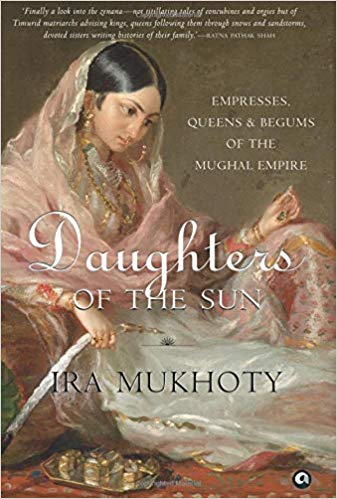Daughters of the Sun chronicles the lives of Mughal women—unmarried daughters, sisters, powerful, dynamic wives, anagas or milk mothers or foster mothers—who contributed to the building of the Mughal Empire. These women often worked from within the zenana or the women quarters; several of these women, however, accompanied the Emperor to the battlefield, engaged in diplomacy, were fiery traders, patrons of arts, aesthetics and literature, known for their remarkable building and architectural sense and the magnificent monuments that they left behind as a legacy. Ira Mukhoty prefers to use the term zenana for the space reserved for women, which as she suggests is more Indian in its origin than harem, a term used by the Europeans to describe a general ‘oriental’ secluded space, whether they referred to the Ottomans in Central Asia or the Mughals in India.
Critical of the notion of ‘oriental harem’, Mukhoty says that it was a creation of the Europeans, ‘a lurid and sometimes fantastical mix of bazaar gossip, stray gleanings of fact and sexual fantasy’. Even as the Europeans interacted with the Mughal court, they had no physical or cultural access to the zenana despite their yearnings. In the absence of the knowledge of Persian and Turki, they could barely understand this ‘beguiling world’ except through an interpreter. A royal woman’s power or influence was beyond their comprehension, which they invariably attributed to the political weakness of the emperor or incest. Fascinated by the idea of a private space for royal Mughal women, they indulged, as Mukhoty says, in ‘some truly fervid leaps of imagination’ when trying to narrate that ‘forbidden world’–-the Mughal harem. These images were ironically adopted not only by the western audiences but also the Indian ones. Challenging the chimera creation of the Europeans as a mere fantasy, Mukhoty suggests that the zenana was an ‘industrious, carefully calibrated and orchestrated world’, characterized by warmth and companionship, complicity and understanding, excellence and skills. It was far removed from, as Mrs. Meer Hassan Ali described the ‘claustrophobic, sexually charged harem of popular imagination’. Mrs. Ali was an Englishwoman married to an Indian who lived in a Muslim nobleman’s household for twelve years in the nineteenth century. John Fryer, too, a physician with the East India Company was amazed by the mundane and industrious environment of the zenana which he accidentally happened to spy upon when the curtain that separated him from his patients suddenly fell.
Mukhoty, through this book, recreates and narrates the dynamism and power of Mughal women from the time of Babur to the end of Aurangzeb’s reign, a period spanning almost 200 years. She talks of influential women—aunts and mothers like Aisan Daulat Begum, Khanzada Begum, Dildar Begum, Gulbadan Begum, Bega Begum, Maham Begum; foster mothers or milk mothers like Maham Anaga and Jiji Anaga; wives like Harkha Bai, Salima Sultan Begum, Nur Jahan and Mumtaz Mahal; daughters who patronized art and literature and were actively involved in politics like Jahanara Begum, Roshnara Begum, Zeb-un-Nisa Begum and Zeenat-un-Nisa Begum. They were erudite and educated, excelled in subjects like mathematics, history, physics, astronomy, calligraphy, literary prose and poetry, upheld Timurid-Chingizid ideals and were as committed to empire-building as the emperors. Mukhoty thus carries forward the argument of Ruby Lal that there was rarely a distinct demarcation between ‘public’ and ‘private’ space for Mughal women. Capturing the emotions and sentiments of Humayun when his six year old daughter Aqiqa died while accompanying him on the battlefield, Mukhoty demonstrates that there was no separation between the ‘public’ and ‘private’—the life of the emperor and his family. Humayun took his haraman with him wherever he went—whether it was a military expedition, battlefield or a pleasure trip.

